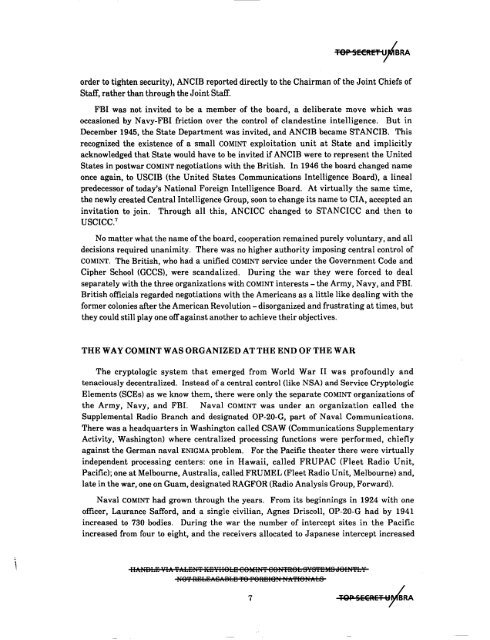American Cryptology during the Cold War - The Black Vault
American Cryptology during the Cold War - The Black Vault
American Cryptology during the Cold War - The Black Vault
Create successful ePaper yourself
Turn your PDF publications into a flip-book with our unique Google optimized e-Paper software.
lap 5fEftf'f ~BRA<br />
order to tighten security), ANCIB reported directly to <strong>the</strong> Chairman of <strong>the</strong> Joint Chiefs of<br />
Staff, ra<strong>the</strong>r than through <strong>the</strong> Joint Staff.<br />
FBI was not invited to be a member of <strong>the</strong> board, a deliberate move which was<br />
occasioned by Navy-FBI friction over <strong>the</strong> control of clandestine intelligence. But in<br />
December 1945, <strong>the</strong> State Department was invited, and ANCIB became STANCIB. This<br />
recognized <strong>the</strong> existence of a small COMINT exploitation unit at State and implicitly<br />
acknowledged that State would have to be invited ifANCIB were to represent <strong>the</strong> United<br />
States in postwar COMINT negotiations with <strong>the</strong> British. In 1946 <strong>the</strong> board changed name<br />
once again, to USCIB (<strong>the</strong> United States Communications Intelligence Board), a lineal<br />
predecessor of today's National Foreign Intelligence Board. At virtually <strong>the</strong> same time,<br />
<strong>the</strong> newly created Central Intelligence Group, soon to change its name to CIA, accepted an<br />
invitation to join. Through all this, ANCICC changed to STANCICC and <strong>the</strong>n to<br />
USCICC. 7<br />
No matter what <strong>the</strong> name of<strong>the</strong> board, cooperation remained purely voluntary, and all<br />
decisions required unanimity. <strong>The</strong>re was no higher authority imposing central control of<br />
COMINT. <strong>The</strong> British, who had a unified COMINT service under <strong>the</strong> Government Code and<br />
Cipher School (GCCS), were scandalized. During <strong>the</strong> war <strong>the</strong>y were forced to deal<br />
separately with <strong>the</strong> three organizations with COMINT interests - <strong>the</strong> Army, Navy, and FBI.<br />
British officials regarded negotiations with <strong>the</strong> <strong>American</strong>s as a little like dealing with <strong>the</strong><br />
former colonies after <strong>the</strong> <strong>American</strong> Revolution - disorganized and frustrating at times, but<br />
<strong>the</strong>y could still play one offagainst ano<strong>the</strong>r to achieve <strong>the</strong>ir objectives.<br />
THE WAY COMINT WAS ORGANIZED AT THE END OF THE WAR<br />
<strong>The</strong> cryptologic system that emerged from World <strong>War</strong> II was profoundly and<br />
tenaciously decentralized. Instead of a central control (like NSA) and Service Cryptologic<br />
Elements (SCEs) as we know <strong>the</strong>m, <strong>the</strong>re were only <strong>the</strong> separate COMINT organizations of<br />
<strong>the</strong> Army, Navy, and FBI. Naval COMINT was under an organization called <strong>the</strong><br />
Supplemental Radio Branch and designated OP-20-G, part of Naval Communications.<br />
<strong>The</strong>re was a headquarters in Washington called CSAW (Communications Supplementary<br />
Activity, Washington) where centralized processing functions were performed, chiefly<br />
against <strong>the</strong> German naval ENIGMA problem. For <strong>the</strong> Pacific <strong>the</strong>ater <strong>the</strong>re were virtually<br />
independent processing centers: one in Hawaii, called FRUPAC (Fleet Radio Unit,<br />
Pacific); one at Melbourne, Australia, called FRUMEL (Fleet Radio Unit, Melbourne) and,<br />
late in <strong>the</strong> war, one on Guam, designated RAGFOR (Radio Analysis Group, Forward).<br />
Naval COMINT had grown through <strong>the</strong> years. From its beginnings in 1924 with one<br />
officer, Laurance Safford, and a single civilian, Agnes Driscoll, OP-20-G had by 1941<br />
increased to 730 bodies. During <strong>the</strong> war <strong>the</strong> number of intercept sites in <strong>the</strong> Pacific<br />
increased from four to eight, and <strong>the</strong> receivers allocated to Japanese intercept increased<br />
Ih\:NBLB VIA ~ALBN~ICBYIIeLEl eer..HN~ eeN~ReL SYS~ElMSdem~LY<br />
Ne~ RflLB/,SABLB ~e FeRElI8U NA~IeNALS<br />
7
















